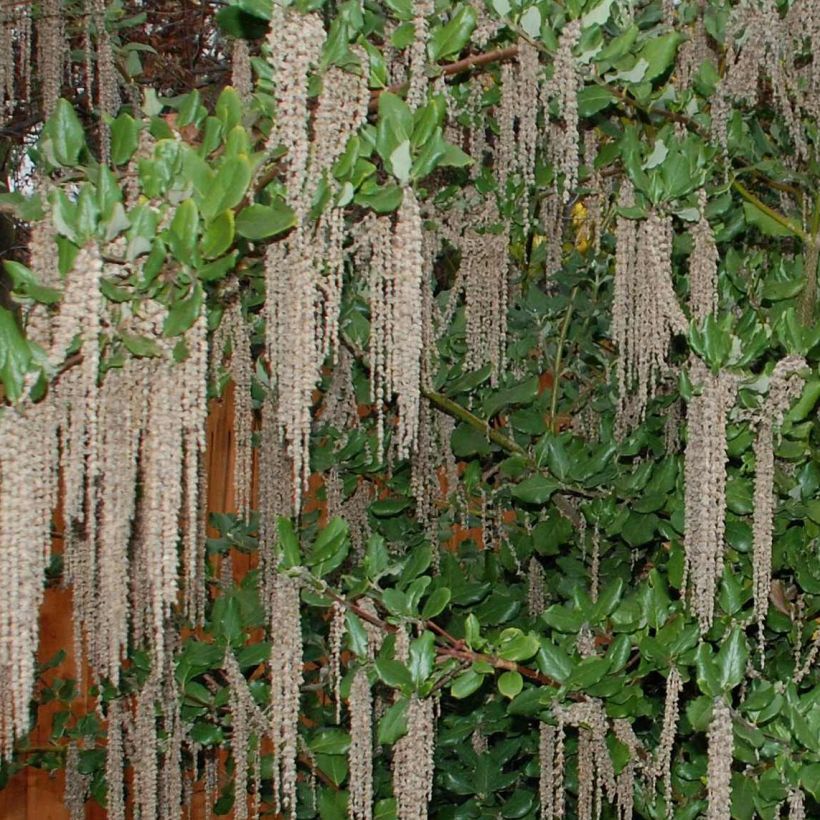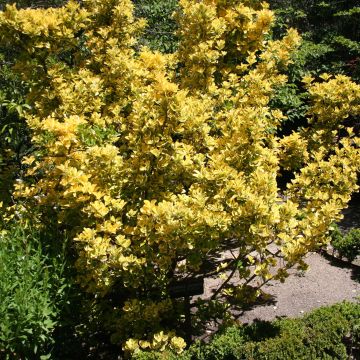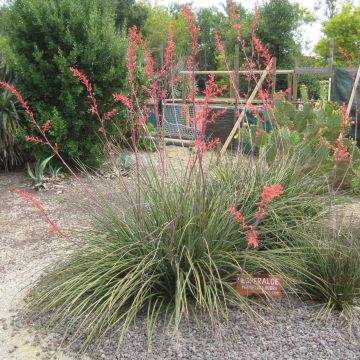

Garrya elliptica James Roof


Garrya elliptica James Roof


Garrya elliptica James Roof


Garrya elliptica James Roof


Garrya elliptica James Roof


Garrya elliptica James Roof


Garrya elliptica James Roof


Garrya elliptica James Roof


Garrya elliptica James Roof


Garrya elliptica James Roof
Garrya elliptica James Roof
Garrya elliptica James Roof
Silk Tassel Bush, Feverbush, Quinine bush, Bear brush
Exactly the habit I needed for the spot where I wanted to plant it!
SHINRA TENSEI, 28/10/2025
Special offer!
Receive a €20 voucher for any order over €90 (excluding delivery costs, credit notes, and plastic-free options)!
1- Add your favorite plants to your cart.
2- Once you have reached €90, confirm your order (you can even choose the delivery date!).
3- As soon as your order is shipped, you will receive an email containing your voucher code, valid for 3 months (90 days).
Your voucher is unique and can only be used once, for any order with a minimum value of €20, excluding delivery costs.
Can be combined with other current offers, non-divisible and non-refundable.
Home or relay delivery (depending on size and destination)
Schedule delivery date,
and select date in basket
This plant carries a 24 months recovery warranty
More information
We guarantee the quality of our plants for a full growing cycle, and will replace at our expense any plant that fails to recover under normal climatic and planting conditions.


Would this plant suit my garden?
Set up your Plantfit profile →
Description
Garrya elliptica 'James Roof' is perhaps the most beautiful cultivar of Garrya elliptica. Its dark-green evergreen foliage with a grey velvety underside stands out all year round, but this large shrub reveals itself in winter, when its spectacular silver-grey flowering appears, in the form of numerous and very long silky catkins that sway in the wind. Covered in frost, as if it were blooming with stalactites, on a misty February morning, this Garrya is breathtakingly beautiful. It is also very accommodating: it is reasonably tolerant to the presence of lime in the soil, sea spray, and even summer drought once established. Grow this wonder in partial shade, in the open ground in areas with mild winters.
Garrya elliptica, sometimes called Silk tassel bush, Coast silk-tassel, Quinine bush or Bear brush, is a shrub of the Garryaceae family. A dioecious flowering shrub - there are female and male individuals, but only the latter are cultivated in our gardens for their unique winter flowering. It is native to the forests of the west coast of the United States, especially to an area that extends from southern Oregon to the middle of California. It is a member of the chaparral, a shrubby formation comparable to Mediterranean scrub vegetation. It is a plant of dry and relatively mild climates, capable of withstanding short frosts around -12 °C (10.4 °F).
Garrya 'James Roof' is a male flower selection that stands out for an even more spectacular flowering than the type species. Of relatively slow growth, the shrub will reach an average size of 2.50 m (8 ft 2 in) in all directions at the age of 15. The habit of this shrub is bushy, ample, but well-branched and very dense. Its branches bear leathery leaves that resemble those of the evergreen oak but are arranged in an opposite manner. They are oval-elliptical in shape, 4 to 8 cm (1.6 to 3.1 in) long, with a smooth and undulate margin, dark green on the upper side, almost grey and pubescent underneath. The shrub starts to flower at the age of 5 or 6 years. Flowering generally takes place in January-February, sometimes as early as December, and continues until March-April depending on the climate. The male inflorescences are silky, trailing catkins up to 40 cm (15.7 in) long. They appear at the axil of the leaves and are composed of a stack of small pale pink-purple flowers with yellow stamens enveloped in a silky, silver-tinged bract.
Well sheltered from cold winds, Garrya elliptica James Roof is hardy to -12 °C (10.4 °F), in properly drained soil. Be careful in case of hard frosts. It is very well adapted to the oceanic climate and is able to tolerate sea spray. It will do better in a warmer urban garden that is protected from cold winds than in the open countryside. It is also suitable for locations with a Mediterranean climate, even without summer watering once well-established, as long as it is planted in partial shade and in deep soil. It is preferably planted as a standalone shrub or as part of a natural hedge in order to fully appreciate its dark branches that often descend to the ground, illuminated by the moving mass of silver catkins. It can be associated with Carolina allspice (Calycanthus), Pheasant Berry (Leycesteria), Smoke Bush (Cotinus), Hardy Fuchsia, Star Magnolia, or Euonymus myrianthus for a refined and ever-changing exotic atmosphere, with all year round interest.
American Indians once used its bark and bitter leaves in a decoction against malaria, from which it gets its name 'quinine bush'.
Report an error about the product description
Garrya elliptica James Roof in pictures






Plant habit
Flowering
Foliage
Botanical data
Garrya
elliptica
James Roof
Garryaceae
Silk Tassel Bush, Feverbush, Quinine bush, Bear brush
Cultivar or hybrid
Planting and care
Choose the location of Garrya elliptica James Roof carefully as it will not tolerate being transplanted. It prefers a sunny to partially shaded spot in warmer areas, sheltered from cold winter winds that would affect its hardiness and damage its beautiful flowering. Plant it in ordinary soil, but ensure the soil is sufficiently deep and well-drained. It is essential to add coarse sand and leaf compost to the planting hole if your soil tends to be clayey and compact. Water abundantly (at least 1 watering can of 11 liters, but space out watering days) in case of severe drought, during the first two to three summers. The shrub will then do without watering, even in hot locations, as long as it is well rooted. Its hardiness is around -12 °C (10.4 °F), for a well-established plant in a sheltered position.
Protect your young shrub with a thick mulch and fleece in areas with borderline hardiness, or if hard frosts are forecasted. Optionally, apply a thick mulch around the base of the plant in summer to maintain soil moisture. Do not prune your shrub excessively, as it will affect its flowering. You can remove dead wood and a few branches in April to restore its shape.
Planting period
Intended location
Care
-
, onOrder confirmed
Reply from on Promesse de fleurs
Similar products
Haven't found what you were looking for?
Hardiness is the lowest winter temperature a plant can endure without suffering serious damage or even dying. However, hardiness is affected by location (a sheltered area, such as a patio), protection (winter cover) and soil type (hardiness is improved by well-drained soil).

Photo Sharing Terms & Conditions
In order to encourage gardeners to interact and share their experiences, Promesse de fleurs offers various media enabling content to be uploaded onto its Site - in particular via the ‘Photo sharing’ module.
The User agrees to refrain from:
- Posting any content that is illegal, prejudicial, insulting, racist, inciteful to hatred, revisionist, contrary to public decency, that infringes on privacy or on the privacy rights of third parties, in particular the publicity rights of persons and goods, intellectual property rights, or the right to privacy.
- Submitting content on behalf of a third party;
- Impersonate the identity of a third party and/or publish any personal information about a third party;
In general, the User undertakes to refrain from any unethical behaviour.
All Content (in particular text, comments, files, images, photos, videos, creative works, etc.), which may be subject to property or intellectual property rights, image or other private rights, shall remain the property of the User, subject to the limited rights granted by the terms of the licence granted by Promesse de fleurs as stated below. Users are at liberty to publish or not to publish such Content on the Site, notably via the ‘Photo Sharing’ facility, and accept that this Content shall be made public and freely accessible, notably on the Internet.
Users further acknowledge, undertake to have ,and guarantee that they hold all necessary rights and permissions to publish such material on the Site, in particular with regard to the legislation in force pertaining to any privacy, property, intellectual property, image, or contractual rights, or rights of any other nature. By publishing such Content on the Site, Users acknowledge accepting full liability as publishers of the Content within the meaning of the law, and grant Promesse de fleurs, free of charge, an inclusive, worldwide licence for the said Content for the entire duration of its publication, including all reproduction, representation, up/downloading, displaying, performing, transmission, and storage rights.
Users also grant permission for their name to be linked to the Content and accept that this link may not always be made available.
By engaging in posting material, Users consent to their Content becoming automatically accessible on the Internet, in particular on other sites and/or blogs and/or web pages of the Promesse de fleurs site, including in particular social pages and the Promesse de fleurs catalogue.
Users may secure the removal of entrusted content free of charge by issuing a simple request via our contact form.
The flowering period indicated on our website applies to countries and regions located in USDA zone 8 (France, the United Kingdom, Ireland, the Netherlands, etc.)
It will vary according to where you live:
- In zones 9 to 10 (Italy, Spain, Greece, etc.), flowering will occur about 2 to 4 weeks earlier.
- In zones 6 to 7 (Germany, Poland, Slovenia, and lower mountainous regions), flowering will be delayed by 2 to 3 weeks.
- In zone 5 (Central Europe, Scandinavia), blooming will be delayed by 3 to 5 weeks.
In temperate climates, pruning of spring-flowering shrubs (forsythia, spireas, etc.) should be done just after flowering.
Pruning of summer-flowering shrubs (Indian Lilac, Perovskia, etc.) can be done in winter or spring.
In cold regions as well as with frost-sensitive plants, avoid pruning too early when severe frosts may still occur.
The planting period indicated on our website applies to countries and regions located in USDA zone 8 (France, United Kingdom, Ireland, Netherlands).
It will vary according to where you live:
- In Mediterranean zones (Marseille, Madrid, Milan, etc.), autumn and winter are the best planting periods.
- In continental zones (Strasbourg, Munich, Vienna, etc.), delay planting by 2 to 3 weeks in spring and bring it forward by 2 to 4 weeks in autumn.
- In mountainous regions (the Alps, Pyrenees, Carpathians, etc.), it is best to plant in late spring (May-June) or late summer (August-September).
The harvesting period indicated on our website applies to countries and regions in USDA zone 8 (France, England, Ireland, the Netherlands).
In colder areas (Scandinavia, Poland, Austria...) fruit and vegetable harvests are likely to be delayed by 3-4 weeks.
In warmer areas (Italy, Spain, Greece, etc.), harvesting will probably take place earlier, depending on weather conditions.
The sowing periods indicated on our website apply to countries and regions within USDA Zone 8 (France, UK, Ireland, Netherlands).
In colder areas (Scandinavia, Poland, Austria...), delay any outdoor sowing by 3-4 weeks, or sow under glass.
In warmer climes (Italy, Spain, Greece, etc.), bring outdoor sowing forward by a few weeks.








































